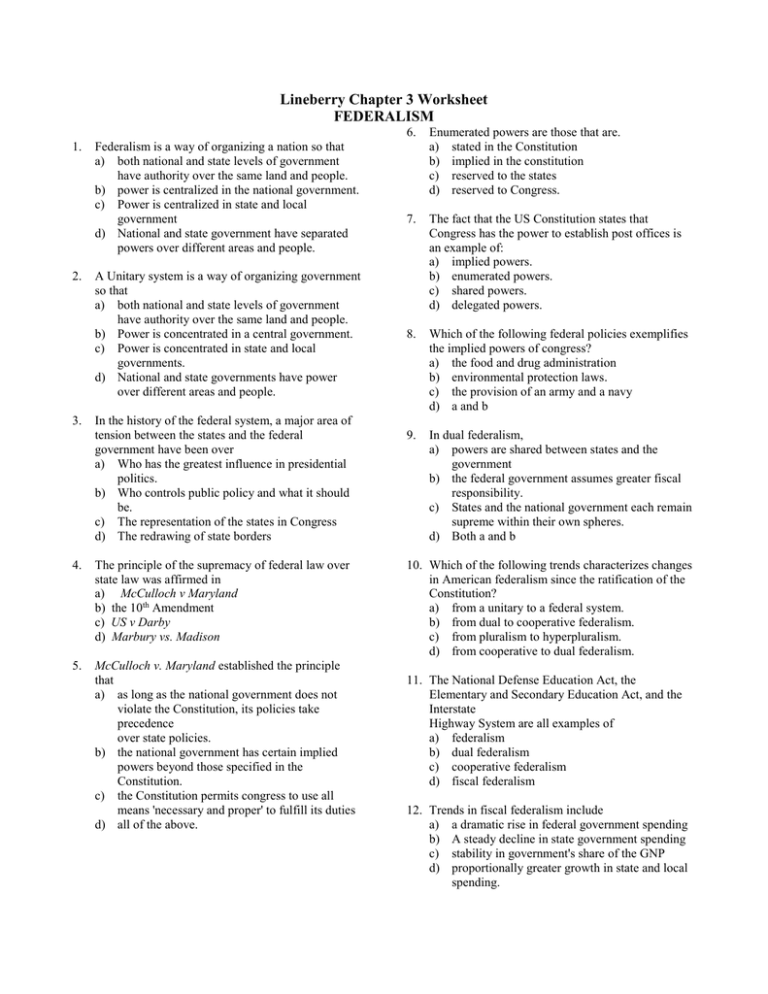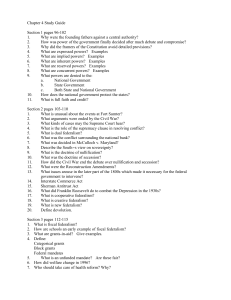Lineberry Chapter 3 Worksheet
advertisement

Lineberry Chapter 3 Worksheet FEDERALISM 1. 2. 3. Federalism is a way of organizing a nation so that a) both national and state levels of government have authority over the same land and people. b) power is centralized in the national government. c) Power is centralized in state and local government d) National and state government have separated powers over different areas and people. A Unitary system is a way of organizing government so that a) both national and state levels of government have authority over the same land and people. b) Power is concentrated in a central government. c) Power is concentrated in state and local governments. d) National and state governments have power over different areas and people. In the history of the federal system, a major area of tension between the states and the federal government have been over a) Who has the greatest influence in presidential politics. b) Who controls public policy and what it should be. c) The representation of the states in Congress d) The redrawing of state borders 4. The principle of the supremacy of federal law over state law was affirmed in a) McCulloch v Maryland b) the 10th Amendment c) US v Darby d) Marbury vs. Madison 5. McCulloch v. Maryland established the principle that a) as long as the national government does not violate the Constitution, its policies take precedence over state policies. b) the national government has certain implied powers beyond those specified in the Constitution. c) the Constitution permits congress to use all means 'necessary and proper' to fulfill its duties d) all of the above. 6. Enumerated powers are those that are. a) stated in the Constitution b) implied in the constitution c) reserved to the states d) reserved to Congress. 7. The fact that the US Constitution states that Congress has the power to establish post offices is an example of: a) implied powers. b) enumerated powers. c) shared powers. d) delegated powers. 8. Which of the following federal policies exemplifies the implied powers of congress? a) the food and drug administration b) environmental protection laws. c) the provision of an army and a navy d) a and b 9. In dual federalism, a) powers are shared between states and the government b) the federal government assumes greater fiscal responsibility. c) States and the national government each remain supreme within their own spheres. d) Both a and b 10. Which of the following trends characterizes changes in American federalism since the ratification of the Constitution? a) from a unitary to a federal system. b) from dual to cooperative federalism. c) from pluralism to hyperpluralism. d) from cooperative to dual federalism. 11. The National Defense Education Act, the Elementary and Secondary Education Act, and the Interstate Highway System are all examples of a) federalism b) dual federalism c) cooperative federalism d) fiscal federalism 12. Trends in fiscal federalism include a) a dramatic rise in federal government spending b) A steady decline in state government spending c) stability in government's share of the GNP d) proportionally greater growth in state and local spending. 13. State governments have often been criticized for a) elitism, corruption and poor management b) The innovation and testing of new policies c) not serving special interests in their state d) not obtaining enough federal funds 14. The efforts of Candy Lightner and Mothers Against Drunk Driving (MADD) to raise the legal drinking age to 21 are an example of a) the supremacy of state government to regulate its own affairs. b) The ability of the national government to influence state policy. c) States acting as policy innovators. d) The unconstitutionality of age discrimination. 15. A marriage license issued in one state is valid and honored in all states under the constitutional provision of a) separation of powers b) privileges and immunities c) full faith and credit d) national licensure 16. Medicaid and Aid for Families with Dependent Children are examples of a) categorical grants b) project grants c) block grants d) formula grants 17. Spending on public education illustrates a) cooperation between states and federal government for unified policy. b) The advantages of fiscal federalism. c) Advantages of relying on states to supply public services. d) The diversity in the quality of education among states as a result of federalism. 18. An example of 'strings' attached to federal aid include a) A ban on the teaching of secular humanism. b) a mandate to raise the drinking age to 21. c) nondiscrimination provisions. d) all of the above. 19. Business interests have traditionally found their demands received most favorably by a) the courts b) Congress c) the president d) state governments 20. A tuition difference between in-state and out of state students is an example of a) dual federalism b) federal exceptions to the full faith and credit provision. c) Full faith and credit is extended across students. d) How states make exceptions to the privileges and immunities clause. THERE ARE 5 FALSE QUESTIONS IN THIS SECTION. 21. Many of our most important policy questions are debated on the battleground of federalism. 22. The central principle of American federalism is the supremacy of the national government. 23. The oldest issue of American federalism concerns the power of the states. 24. Intergovernmental relations refers to the interactions between various levels of government and their officials. 25. One power given to the national government but denied to the states by the Constitution is the Power to coin money. 26. The question of where power lies when states and federal policies are in conflict was definitively answered in the Tenth Amendment. 27. National consumer protection laws and the national bank are both examples of the implied powers of Congress. 28. Federalism has been the battleground where equality issues are fought in American politics. 29. In cooperative federalism, states are exclusively held responsible for schools, law enforcement, and road building. 30. The powers of state and federal governments overlap less in dual federalism than in cooperative federalism. 31. Sharing costs and administration, and observing federal guidelines, are standard operating procedures on which cooperative federalism rests. 32. While the federal government's share of total government spending has grown, most of this growth is accounted for by increased spending for national defense and social security. 33. The danger of multiplicity of governments is the threat of pluralism 34. The primary interest of cities is the maintenance and enhancement of their economic productivity. 35. Federal grants of the categorical type come with plenty of strings attached. 36. States can protect themselves from having to enforce federal policies by applying for block grants. 37. In the past 20 years, cities and states have become less dependent on federal aid and grants. FILL IN THE BLANK 38. __________________________ is a way of organizing a nation so that two levels of government have formal authority over the same land and people. 39. A ________________________ form of government consists of one level of government at the national level in which all formal authority is vested. 40. The _______________________ states that powers not delegated to the national government by the Constitution, nor prohibited to the states, are reserved to the states or to the people. 41. In __________________________, Supreme Court Justice John Marshall accepted Daniel Webster's argument for a broader interpretation of the Constitution concerning the powers of the national government. 42. ___________________________ powers are the powers of Congress to "make all laws necessary and proper" for executing the powers of Congress that are explicitly stated in the Constitution. 43. In ____________________________ federalism, powers and policy assignments are shared between states and the federal government. 44. ________________________ federalism is a name for the patterns of spending, taxing, and awarding grants in the federal system. 45. When policy goals can be thwarted by the fragmentation of governmental power, _________________________ dominates. 46. _____________________ grants can be used only for specific purposes of state and local spending and come with strings attached. 47. _____________________ grants are routinely given to states or communities to support social services and other broad programs. 48. A type of federal aid that is restricted to local governments and has few strings attached is _______________________. Answers: 1) A 2) B 3) B 4) A 5) D 6) A 7) B 8) D 9) C 10) B 11) C 12) A 13) A 14) B 15) C 16) D 17) D 18) B 19) D 20) D False statements 26, 29, 33, 36, 37 38) 39) 40) 41) 42) 43) 44) 45) 46) 47) 48) federalism unitary 10th Amendment McCulloch v Maryland Implied powers Cooperative Fiscal Hyperpluralism Categorical Block Revenue sharing COMPARE AND CONTRAST THE FOLLOWING TERMS (3-5 sentences each) 51) Intergovernmental relations and fiscal federalism 52) Supremacy clause and Tenth Amendment 53) Enumerated powers and implied powers 54) Full faith and credit, extradition, and privileges and immunities 55) Project grants and formula grants 56) Dual federalism and cooperative federalism








